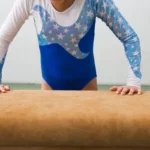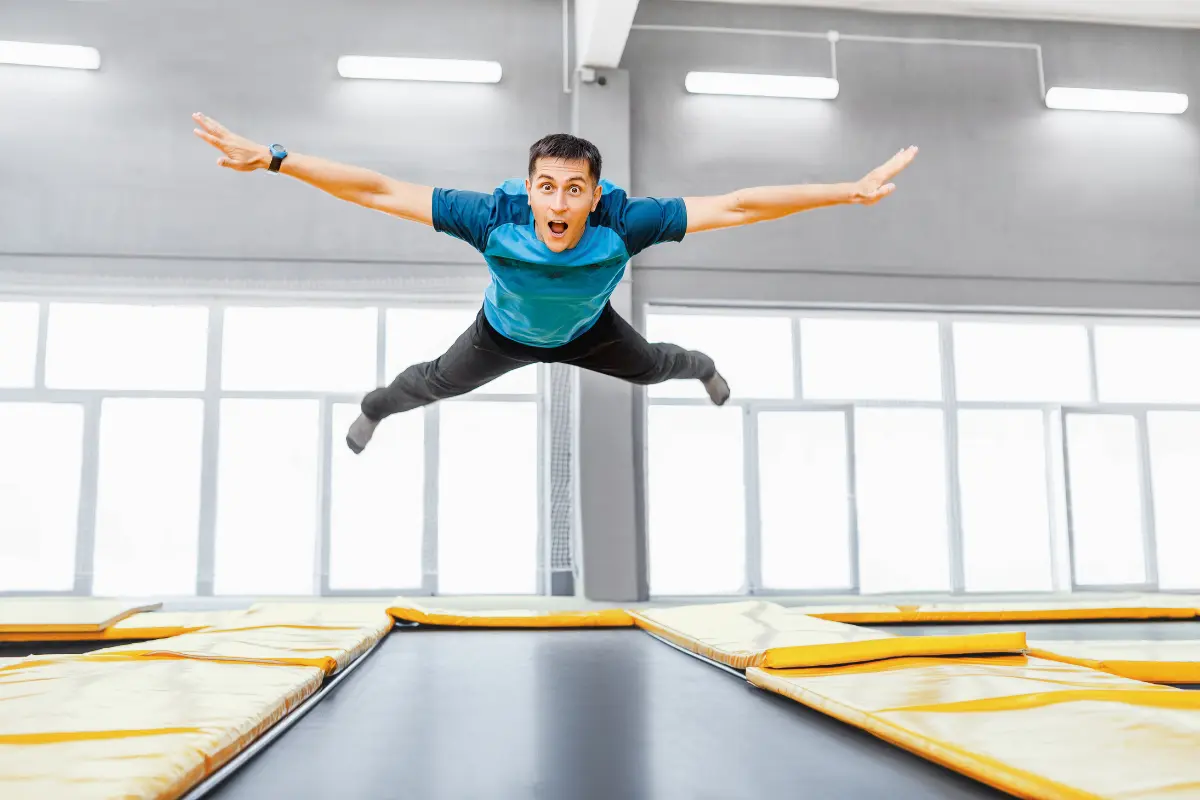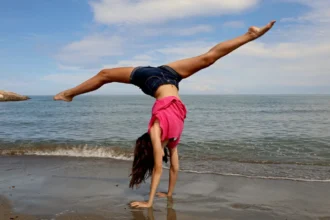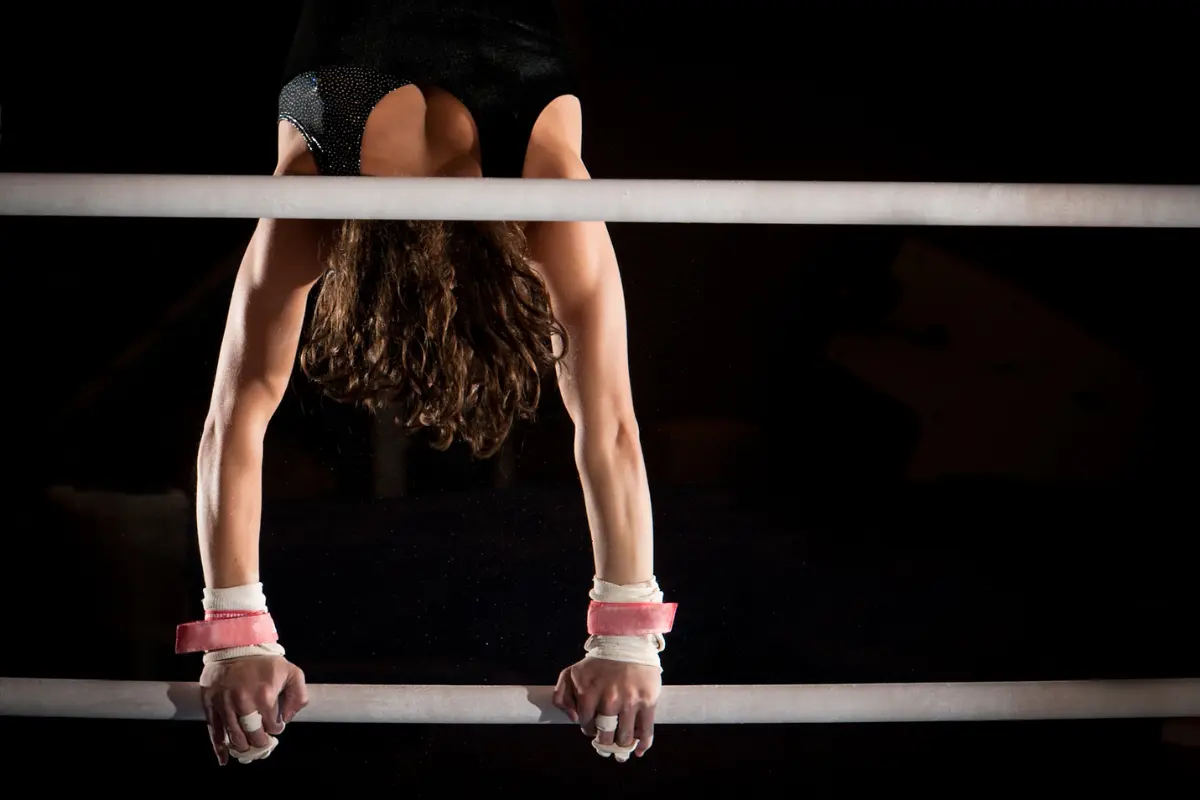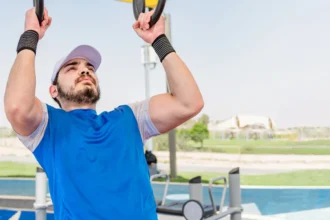If you’re ready to upgrade your tumbling game from “pretty good” to jaw-dropping, this list is for you. These 9 tricks are perfect for gymnasts, cheerleaders, dancers, trickers—or anyone with a love for flipping and flair. They range from classic crowd-pleasers to lesser-known moves with people asking, “Wait, how did you do that?”
And the best part? They’re not just for elites—most of these are achievable with training, and they all pack serious wow factor.
| Trick | Difficulty | Short Description | Crowd‑Wow Factor |
|---|---|---|---|
| Valdez (Back Walkover from Sitting) | ★★☆☆☆ | Flexible back walkover starting from seated. | Medium – Unique and graceful |
| Dive Roll | ★★☆☆☆ | Dramatic forward dive into a roll. | Medium – Looks like a stunt |
| Aerial Cartwheel | ★★★☆☆ | No-hand cartwheel; flips sideways in the air. | High – Hands-free flipping |
| Side Aerial | ★★★☆☆ | No-hand sideways flip with dance-like flow. | High – Smooth and stylish |
| Barani (Front Tuck + Half Twist) | ★★★☆☆ | Forward flip with a twist, lands backward. | High – Twist catches eyes |
| Roundoff BHS Back Tuck | ★★★★☆ | Classic tumbling combo into a backflip. | High – Fast & flippy combo |
| Cheat Gainer | ★★★★☆ | Tricking flip: sideways takeoff into a backflip. | Very High – Looks impossible |
| Standing Full Twist | ★★★★☆ | Full 360° twist in a standing backflip. | Very High – Pure power move |
| Punch Front Step-Out to Full | ★★★★★ | Front flip (step-out) into a full twisting backflip. | Very High – Complex & flashy |
Valdez
A graceful back walkover from a sitting position
The Valdez is a lesser-known but seriously cool tumbling move that blends strength, flexibility, and drama into one slick trick. It’s essentially a back walkover, but instead of starting from a standing position, you begin sitting on the floor—then flip yourself backward onto your feet.
Why it wows: Most people don’t expect a full flip from sitting. It looks slow and beautiful—then bam, you’re on your feet.
How It Works:
- Sit on the floor with legs bent and one arm planted behind you.
- Use your arm and opposite leg to push into a back bridge position.
- As your hips rise, kick your back leg over your head.
- Continue the motion like a back walkover, landing one foot at a time.
It’s basically a one-armed, back walkover with flair—but from the floor. Core strength and shoulder flexibility are key.
Tip to learn: Master a solid bridge and back walkover first. Then build strength and flexibility in your shoulders and core.
Dive Roll
A forward flip with a stuntman twist
If you’ve ever watched an action movie or a circus acrobat, chances are you’ve seen a dive roll. It’s exactly what it sounds like: a powerful forward dive through the air that ends in a smooth roll. It’s one of the most dramatic “simple” tricks in tumbling—and it looks way harder than it is once you get the motion down.
Why it wows: It’s a stunt double’s go-to—big leap, smooth landing, and huge airtime.
How It Works:
- Start in a standing position with your arms extended forward.
- Jump forward with a stretched body, like you’re diving into a pool.
- Just before landing, tuck your chin and initiate a smooth front roll.
- Land the roll and return to standing with control.
The key is keeping your body extended during the “dive” and transitioning into the roll just in time to avoid crashing. It’s all about timing, body control, and a fearless jump.
Tip to learn: Start with a forward roll, build your dive power slowly, and practice over stacked mats or cushions for safety.
Aerial Cartwheel
A no-handed cartwheel that looks like a sideways flip
The aerial cartwheel is a classic crowd-pleaser in tumbling, cheer, and dance. It’s exactly what it sounds like: a full cartwheel done without using your hands. You launch yourself into the air sideways, rotate like a cartwheel, and land on your feet—all while staying completely airborne.
Why it wows: People don’t expect you to go upside down without your hands. The skill has a floaty, flying look that feels almost magical when done well.
How It Works:
- Begin with a strong run or hurdle step for momentum.
- Swing your leading leg high and fast to create lift.
- Your trailing leg follows as you kick into the air sideways.
- Rotate like a cartwheel, but keep your hands off the ground.
- Land one foot at a time, facing the direction you traveled.
The aerial is all about speed, leg drive, and confidence—it’s a skill that looks effortless but takes real coordination and commitment.
Tip to learn: Build leg power and speed. Use a springboard or raised surface to begin, and gradually remove your hands during drills.
Side Aerial
A graceful no-handed sideways flip with a dancer’s touch
The side aerial is like the aerial cartwheel’s elegant sibling. While both are hands-free and travel sideways, the side aerial tends to look more controlled, floaty, and dance-like. It’s commonly performed in gymnastics floor routines and dance performances because it blends acrobatics with style.
Why it wows: It’s smooth, silent, and stylish—like you’re flying sideways without even trying. People always do a double take when they realize you didn’t touch the ground with your hands.
How It Works:
- Start with a hurdle or run to generate momentum.
- Swing your lead leg upward to initiate the lift-off.
- Your torso stays upright longer than in a typical aerial cartwheel.
- Both legs lift off the ground as you rotate sideways through the air.
- Land one leg at a time, smoothly and softly.
The motion is more arched and controlled than a flipping trick, which gives it that graceful quality. Flexibility, balance, and leg strength all play a major role.
Tip to learn: Start with a strong cartwheel and hurdle. Train flexibility, timing, and spotting technique to nail the rotation.
Barani
A front flip with a half twist that lands backward
The Barani is a tumbling trick that combines a front tuck with a half twist, allowing you to take off facing forward and land facing backward. It’s a sleek, twisting flip that looks advanced and stylish—often used in gymnastics, cheer, and tricking. The twist element adds complexity and surprise to an otherwise familiar motion.
Why it wows: It throws off your audience (and sometimes your brain)—you flip forward, but land like you flipped backward. The twist is quick, the motion is sharp, and it feels like a ninja move.
How It Works:
- Begin with a run-up or punch takeoff like a front tuck.
- Jump forward with tight arms and a lifted chest.
- Initiate the half twist by rotating through your shoulders and head.
- Spot your landing as you complete the twist.
- Land softly, facing the opposite direction you started from.
The Barani is a great bridge skill between forward and backward tumbling—because it ends like a backflip, it flows beautifully into backward combos.
Tip to learn: Nail your front tuck first, then add the twist late in the flip. It helps to work drills into a foam pit or on a trampoline.
Roundoff Back Handspring Back Tuck
A classic tumbling combo with speed, power, and a flip at the end
The roundoff back handspring back tuck is one of the most iconic tumbling passes in gymnastics and cheer. It links three powerful elements into one fluid motion: a roundoff to build momentum, a back handspring for speed and lift, and a back tuck for the grand finale. It’s fast, explosive, and seriously fun to perform.
Why it wows: It’s the gold standard of tumbling. When you hit it cleanly, it looks like one seamless blur of acrobatic power—and casual spectators are always blown away by the flip at the end.
How It Works:
- Start with a run or hurdle into a strong roundoff.
- Use the momentum from the roundoff to snap into a back handspring.
- At the end of the back handspring, jump upward and tuck your knees in tightly.
- Rotate backward in the air and spot your landing.
- Open up and land on your feet, standing tall.
Each part flows directly into the next, and timing is everything. The more explosive your roundoff and back handspring, the easier the tuck will feel.
Tip to learn: Get confident with your roundoff + BHS combo. Then train standing back tucks before combining them for a full tumbling pass.
Cheat Gainer
Side takeoff, backflip finish—tricker style
The cheat gainer is a flashy, off-axis backflip that’s a favorite in martial arts tricking and freerunning. Unlike a traditional backflip, you take off from a sideways or angled step, almost like you’re spinning out of nowhere—and still rotate backward through the air. It’s one of those moves that looks impossible, even though it’s surprisingly learnable with the right technique.
Why it wows: It’s flashy, stylish, and confusing in the best way—like a street-style backflip.
How It Works:
- Start from a wide, sweeping step (called a “cheat setup”) with your body angled sideways.
- Swing your arms and lift your takeoff leg to generate upward and rotational momentum.
- Tuck or layout as you flip backward while your body moves slightly off-axis.
- Spot your landing and touch down smoothly, usually facing forward or at an angle.
The cheat gainer doesn’t go straight up and down like a typical flip—it has horizontal travel and a twisted pathway through the air, making it a true “tricking” move.
Tip to learn: Start with a gainer step on soft ground. Build your rotation with trampoline drills and keep your chest up during takeoff.
Standing Full Twist
A full flip with a full 360° twist—no run-up needed
The standing full twist—or simply “standing full”—is a high-level tumbling skill where you do a complete backflip with a full twist, all from a standstill. No run, no setup, just explosive power and precise air control. It’s a go-to move for advanced cheerleaders, gymnasts, and trickers who want to throw down something spectacular on the spot.
Why it wows: There’s no momentum helping you—you just jump, flip, spin, and land like it’s nothing.
How It Works:
- Start from a standing position with arms overhead.
- Jump straight up with tight form, initiating a backflip.
- Simultaneously twist your shoulders and arms to initiate the 360° spin.
- Stay tight in the air, keep your eyes spotting the landing, and open up just in time.
- Land on your feet, ideally without stepping or hopping.
The standing full requires perfect timing—if the twist is too early or too late, the landing gets tricky. It’s a mix of technique and pure vertical power.
Tip to learn: Master your standing back tuck first. Practice twisting drills on trampolines and build up your height and control gradually.
Punch Front Step-Out to Full
Flip forward, step out, then flip backward with a twist
The punch front step-out to full is a combo tumbling pass that switches directions mid-air and finishes with a full twisting backflip. First, you launch into a front tuck and land one foot at a time (step-out), giving you enough time to reset and take off backward into a full twist. It’s fast, powerful, and looks incredibly fluid when done right.
Why it wows: You flip forward, then flip backward with a twist. Audiences go wild.
How It Works:
- Begin with a run-up or hurdle into a punch front tuck, landing in a step-out (one foot at a time).
- As the back foot touches, immediately rebound into a back layout with a 360° twist (full).
- Maintain tight body control throughout to link both flips smoothly.
- Spot your landing and finish with clean posture.
The trick is in the transition—landing the punch front with just the right amount of momentum and timing to go straight into the full without hesitation.
Tip to learn: Train each skill separately. Work on quick transitions and direction change drills on a spring floor.


